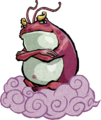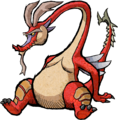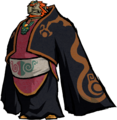| Don't like the ads? Then create an account! Users with accounts have more options than anonymous users. |
Difference between revisions of "The Legend of Zelda: The Wind Waker"
(supporting. i have a plan for supporting) |
(→Supporting characters: deities) |
||
| Line 29: | Line 29: | ||
===Supporting characters=== | ===Supporting characters=== | ||
<gallery | <gallery> | ||
Aryll TWW artwork.png|[[Aryll]] | Aryll TWW artwork.png|[[Aryll]] | ||
Daphnes Nohansen Hyrule TWW artwork.png|[[Daphnes Nohansen Hyrule]] | Daphnes Nohansen Hyrule TWW artwork.png|[[Daphnes Nohansen Hyrule]] | ||
Grandma TWW artwork.png|[[Grandma]] | Grandma TWW artwork.png|[[Grandma]] | ||
Makar TWW artwork.png|[[Makar]] | Makar TWW artwork.png|[[Makar]] | ||
Medli TWW artwork.png|[[Medli]] | Medli TWW artwork.png|[[Medli]] | ||
Orca TWW artwork.png|[[Orca]] | Orca TWW artwork.png|[[Orca]] | ||
Princess Zelda TWW artwork.png|[[Princess Zelda]] | |||
Tingle TWW artwork.png|[[Tingle]] | Tingle TWW artwork.png|[[Tingle]] | ||
</gallery> | |||
The following are supporting characters who are a spirit or another form of deity. | |||
<gallery> | |||
Cyclos TWW artwork.png|[[Cyclos]] | |||
Fado TWW artwork.png|[[Fado]] | |||
Great Deku Tree TWW artwork.png|[[Great Deku Tree]] | |||
Great Fairy TWW artwork.png|[[Great Fairy]] | |||
Jabun TWW artwork.png|[[Jabun]] | |||
Laruto TWW artwork.jpg|[[Laruto]] | |||
Queen of Fairies TWW artwork.png|[[Queen of Fairies]] | |||
Valoo TWW artwork.png|[[Valoo]] | Valoo TWW artwork.png|[[Valoo]] | ||
Zephos TWW artwork.png|[[Zephos]] | |||
</gallery> | </gallery> | ||
Revision as of 21:03, June 17, 2019
| The Legend of Zelda: The Wind Waker | |
|---|---|

| |
| Developer(s) | Nintendo EAD |
| Publisher(s) | Nintendo |
| Release date | |
| Genre(s) | Action-adventure |
| Console(s) | Nintendo GameCube |
| Mode(s) | Single player |
| Input | Nintendo GameCube Controller |
 This article is a stub. You can help Triforce Wiki by expanding it.
This article is a stub. You can help Triforce Wiki by expanding it.
The Legend of Zelda: The Wind Waker is the tenth installment of The Legend of Zelda series. It was first released on the Nintendo GameCube in 2002 in Japan and the following year in North America, Europe, and Australia. In 2013, the game was remastered and re-released for the Wii U with the title, The Legend of Zelda: The Wind Waker HD.
As suggested from the box art, much of the game involves Link traveling across the Great Sea to other islands, by riding a talking boat, the King of Red Lions. Similar to The Legend of Zelda: Ocarina of Time, which features the titular Ocarina of Time, The Legend of Zelda: The Wind Waker is also named after instrument, in this case, the Wind Waker.
The Legend of Zelda: The Wind Waker is noted for its distinctive cartoon-like cel shading visuals, a departure from that of The Legend of Zelda: Ocarina of Time and The Legend of Zelda: Majora's Mask. As a result, fans were divisive over the art style, and while The Legend of Zelda: The Wind Waker was one of the best-selling titles for the GameCube, it had significantly fewer sales than The Legend of Zelda: Ocarina of Time. In response to this, the realistic visuals were added into the next home console game, The Legend of Zelda: Twilight Princess.[1]
The Legend of Zelda: The Wind Waker received two direct sequels for the Nintendo DS, both of which have a similar art style, The Legend of Zelda: Phantom Hourglass and The Legend of Zelda: Spirit Tracks. In the Super Smash Bros. series, the Link from The Legend of Zelda: The Wind Waker and its sequels is named Toon Link, to discern from normal Link and Young Link.
Characters
Main protagonists
Supporting characters
The following are supporting characters who are a spirit or another form of deity.
Bosses
Names in other languages
| Language | Name | Meaning |
|---|---|---|
| Japanese | ゼルダの伝説 風のタクト Zeruda no Densetsu: Kaze no Takuto |
The Legend of Zelda: Baton of Winds |



























